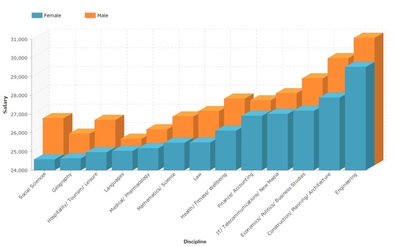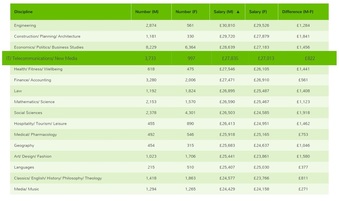|
The gender pay gap has been a longstanding issue in the workplace, but recent data suggests that a possible cause for this could be the differences in job application behaviour between male and female graduates.
A study conducted by Totaljobs has revealed that there is a significant gap between the salaries of jobs that male and female graduates apply for.
According to the data, jobs that male graduates apply for are paid on average £2,000 more than those that female graduates apply for. Examples of this include the fields of social sciences (where the average salary of male graduate applications is £26,503 compared to the female’s £24,585), engineering (£30,810 to £29,526), and law (£26,895 to £25,487).
The research also shows that there are fewer women applying for the higher paying jobs in general. Engineering has the highest average salary for its graduate applications, yet 2,874 men applied for a job in the discipline compared to only 561 women.
Comparisons were similar in other high-paid disciplines, including construction, planning, and architecture (1,181 male applications to 330 female applications), economics, politics, and business studies (8,229 to 6,364), and IT, telecommunications, and new media (3,733 to 997.)
The implications of this data could be that the gap in pay between the two genders could be a result of different approaches to job applications on the part of male and female applicants. Helen Wollaston, a director of the WISE Campaign (Women into Science and Engineering) said:
“Dr Barnes' numbers for the four STEM categories do show a small (3-4%) but significant bias in salary expectations in favor of men. WISE research in partnership with Network Rail has established that women evaluate job opportunities in a much broader way than men and maximising salary is not necessarily at the top of the list. Women are just as interested in the working environment and the overall contribution the job makes as they are in the salary and the precise nature of the work activities.”
This does however raise an important question: is society doing enough to encourage women to pursue a high-end career? A poll run by CWJobs investigated the issue of gender equality in the IT and Technology industries by examining levels of interest and encouragement received by both male and female applicants regarding a career in IT.
The results show that there were more women who had no interest in IT during their school years than men (47% of men to 63% of women). While these figures dropped when considering the present time, there were fewer women who gained an interest in a career in IT than men – 28% of men said they had no interest now, 40% less than in their school years, while 50% of women said they were still not interested, only 20% less than in their school years. The poll also inquired as to the level of encouragement that men and women felt they had received at a young age, and interestingly the numbers show a significant difference between the genders (35% of men felt they were encouraged to pursue a career in IT by their parents, compared to 25% of women). The imbalance was also consistent for other members of their families (25% of men to 15% of women), educational guidance (38% to 30%), and society in general (33% to 24%). These statistics appear to support the theory that the gender pay gap may be influenced by factors that affect men and women before they enter employment, going as far back as their early childhood education. With such a disparity in the presence of females within these industries compared to their male counterparts, it stands to reason that women often feel more inclined to apply for lower-tier positions. The CEO of the British Fashion Council, Caroline Rush, spoke about how an example could be set for women in the fashion industry: “Women are equal to men and so we absolutely need to ensure that aspirations are equal. The more female leaders we have and the more there are women on the boards of businesses operating within the fashion industry, the easier it will be to set aspiration.” A similar approach in all industries could be the solution for encouraging women into higher-end careers or higher-paying job applications and finally closing the gender pay gap. Comments? Leave them below!
0 Comments
Your comment will be posted after it is approved.
Leave a Reply. |
Archives
July 2022
CategoriesAll Amy Massack BiWeekly Roundup Danae Dodge Gabrielle-Ann Torre Indulekha Karunakaran Jeesoo Sohn Lauren Koenig Lidiya Angelova Melissa Bendayan Microsoft Molly Connell Nektaria Riso Nicole Hellessey Physics Poornima Peiris Robbin Koenig Sadaf Atarod Sarah Smith Shreya Challa Vijendra Agarwal Women In STEM Yolanda Lannquist |
The Network for Pre-Professional Women in Science and Engineering
The Scientista Foundation is a registered 501(c)(3) -- Donate!



 RSS Feed
RSS Feed